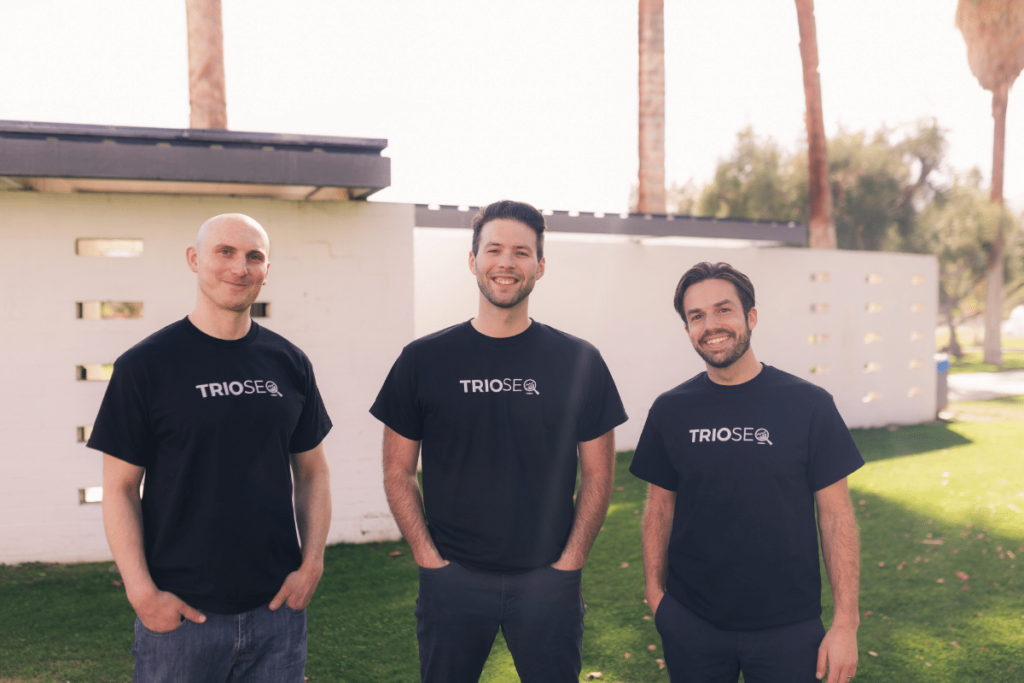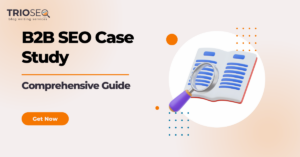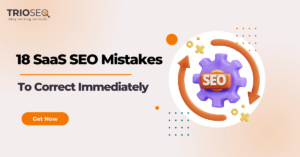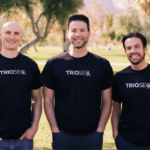SaaS content writing makes complex software solutions understandable and appealing to a broad audience.
It’s no easy feat, but if you do it right, the specialized craft of content writing for B2B SaaS can turn technical specs into engaging stories, educating and converting readers into loyal subscribers.
In this blog post, we’ll explain:
- The nuances of content writing for SaaS
- How to find the best SaaS SEO agency to promote your business.
If you’d rather have an expert handle your content and SEO strategy ASAP, turn to TrioSEO.
With 10+ years of expertise in the field, we’re ready to expertly handle your B2B SaaS content writing needs.
What is SaaS Content Writing?
SaaS writing is the process of creating specialized written materials for Software as a Service (SaaS) companies.
The goal is to articulate the value of your software, engage and educate your company’s target audience, and drive sales, typically through:
- Informative writing: Blog posts, articles, whitepapers, etc.
- Marketing writing: Product descriptions and copies highlighting your SaaS offerings’ benefits, features, and applications.

How is SaaS Content Writing Different from Other Writing Forms?
To promote your software solutions, SaaS writers must distill complex, often technical, information into clear business benefits your ideal customers care about.
Their writing caters to the needs of tech-savvy businesses and individuals looking for cutting-edge software applications. This type of writing is challenging because it employs persuasive and copywriting techniques that aim to simultaneously:
- Explain tech in plain language
- Directly link your technology to how customers can grow with it and gain a competitive advantage.
Here’s how SaaS writing differs from other forms of writing:
| Feature | Writing for SaaS | Other Writing Forms |
|---|---|---|
| Purpose | Promote SaaS products/services | It can vary widely - informative, entertainment, persuasion, etc. |
| Audience | Tech-savvy individuals and businesses interested in SaaS solutions | Ranges from the general public to specific interest groups. |
| Technicality | It requires understanding software, cloud computing, and SaaS industry trends. | It depends on the subject matter. |
| Keywords | Industry-specific terms related to SaaS and tech | It varies based on the field/subject being addressed. |
| Content type | Blog posts, case studies, whitepapers, and product descriptions | Novels, news, articles, essays, and more |
| Goal | To educate, engage, and convert readers into users | To inform, entertain, persuade, etc |
| SEO focus | High emphasis on SEO to attract targeted traffic through specific SaaS-related queries. | High SEO emphasis to enhance visibility and attract targeted traffic in that specific industry/niche. |
Types of SaaS Content Writing
SaaS companies communicate their value proposition and drive growth by creating the following types of content:
1. SEO Content Writing
SEO writing overlaps with all the other types of content writing for SaaS. Its goal is to ensure that, besides being informative and engaging, every piece of written content ranks well on search engine results pages (SERPs).
SaaS SEO content strategically incorporates relevant keywords, addresses search intent and follows best SEO practices. It helps SaaS companies with the following:
- Enhancing online visibility
- Attracting target traffic
- Converting readers into customers
If you need to optimize your website pages and blog content to drive more traffic and revenue from search results, check out how our SaaS SEO agency can help.
2. Blog Posts
As a cornerstone of SaaS writing, blog posts are a tool for SEO and for establishing thought leadership. Writing such content will:
- Provide a versatile platform to address industry trends, solve problems, and share insights related to your SaaS product.
- Increase your authority, build brand awareness, and encourage engagement with potential customers.

3. Case Studies and Success Stories
SaaS products must provide real-world value, which is exactly what case studies and success stories showcase.
By giving concrete examples of how the product solves specific problems for its users, these narratives build credibility and trust among potential customers.
4. Whitepapers and E-books
Offering an in-depth exploration of industry challenges, trends, and solutions, whitepapers, and e-books can position your SaaS company as an expert.
They also educate your target audience while generating leads through downloads.
5. Email Newsletters
Email newsletters inform your subscribers about the latest updates, tips, and offers related to your SaaS product. Sending regular emails helps:
- Nurture leads
- Maintain engagement with existing customers
- Drive conversions through targeted content
6. Product Descriptions and Landing Pages
Essential for showcasing your SaaS product’s value, product descriptions, and landing pages detail the features, benefits, and your unique selling propositions.
These content pieces are generally optimized for user experience and search engines.
7. Help Guides and Tutorials
Whether for onboarding new customers, reducing support queries, or enhancing user satisfaction, help guides and tutorials provide step-by-step instructions for using your SaaS product effectively.

How to Write Great SaaS Content That Converts
SaaS content must guide your potential customers through the decision-making process. That’s why it has to be clear, engaging, persuasive, and optimized for search engines to result in better conversions.
To achieve this, your SaaS writer must know the product in-depth, and they must also:
- Understand your audience: Tailored content resonates more effectively. Discover your target audience’s needs and challenges and the solutions they seek.
- Focus on benefits, not just features: Except for the tech-savvy, highly sophisticated readers excited by specs, target audiences are typically more interested in the outcomes than the technical specifications. Highlight how your SaaS solution improves lives or businesses.
- Use an engaging, conversational tone: A light and friendly tone makes complex information more accessible. Write as if you’re speaking directly to the reader.
- Incorporate SEO strategically: Research and use keywords your target audience is searching for. However, ensure the content flows naturally and doesn’t feel stuffed with keywords.
- Include clear Calls to Action (CTAs): Effective CTAs turn readers into leads. Tell your readers what to do next — sign up for a trial, schedule a demo, download a guide, etc.
- Leverage social proof: Incorporate testimonials, case studies, and success stories to build trust and credibility.
- Optimize for readability: Make your content easy to scan with short paragraphs, bullet points, and subheadings.
When writing any SaaS content, aim for two things:
- Educate, engage, and convince your audience that your solution is the right choice.
- Show search engines that your content provides exactly what readers are looking for online.
Our expert SEO strategists and SaaS writers at TrioSEO can help you with both. When you apply to work with us, we’ll offer you a free SEO audit before crafting the perfect SaaS content plan.

Metrics to Track the Effectiveness of Your SaaS Content
So, you’ve crafted stellar SaaS content, but how do you gauge its impact? Monitoring the following key metrics will tell you how well your content connects with your audience and drives toward your business objectives:
1. Traffic Metrics
To discover which content captures your audience’s attention most and gain some insights on market penetration, check out your:
- Page Views: The total number of times visitors view your page — including repeated views — indicates how often that content is accessed and suggests popularity or interest.
- Unique Visitors: This number represents the persons who visit your site, regardless of how many times they do it.
2. Engagement Metrics
Initial engagement and your site’s navigational appeal are critical for designing a simple and clear user journey that converts. Here are some metrics to track this appeal:
- Bounce Rate: Bounce rate is the percentage of visitors who leave your site after viewing only one page. Depending on the industry, it can oscillate from 26% to 70%, and it’s estimated at 48.24% in SaaS. Also, this number correlates to first-page Google rankings.
- Average Time on Page: This metric measures how long your visitors spend on a specific page, indicating the engagement level. A higher average time suggests that your content is captivating. While the average time visitors spend per page across all industries is 54 seconds, the B2B industry has the highest value at 1.37 minutes.
- Pages per Session: The average number of pages a visitor views in a single session shows how effectively your content encourages visitors to explore more of your site. Page per session benchmarks show an average of 5 across all industries, with B2B at the lowest of 2 page views per session.
3. SEO Metrics
Want to keep your SEO health in check? Monitor the following metrics to track how your content ranks and if it organically draws in target users from search engines:
- Keyword Rankings: These rankings show your website’s position in search engine results for specific keywords. The higher your content appears in the SERP, the more visibility and organic traffic you get.
- Organic Search Traffic: This measures how many people land on your website each month from Google or other search engines. While this benchmark varies from one SaaS business to another, Gitnux says SEO brings SaaS businesses 14.3% leads from organic search.

4. Conversion Metrics
These metrics measure the direct impact of your content on your bottom line. Check out your:
- Conversion Rate: This percentage represents the number of visitors who take a desired action out of the total number of visitors, and it measures effectiveness in actions like signing up. A 5% conversion rate means 5 out of every 100 visitors complete that action.
- Lead Generation: This metric calculates the percentage of visitors that become leads (by giving you their contact info in response to your content) from the total number of visitors during a specific period. The above-mentioned Gintux source also says that SaaS businesses using content marketing report a lead generation growth of up to 400%.
5. Social Metrics
Social media metrics like the ones below indicate if your content resonates with the audience, engages them, and whether it has viral potential:
- Shares and Likes: The number of times people like or share your content on social media indicates approval and the potential for viral spread.
- Comments: This metric counts people’s comments on your content, showing engagement and interest. However, the best insights come from qualitative analysis, which looks at what people say about your content.
6. Email Metrics
Email is a vital direct communication strategy for your SaaS business. You want to guide it by looking at:
- Open Rate: The percentage of recipients who open your email out of the total number sent measures the initial appeal of your emails. Email provider Mailchimp says the average open rate for software and web apps is around 28.11%.
- Click-Through Rate (CTR): The percentage of email recipients who click on one or more links in an email indicates how effective your email is in encouraging recipients to act. Mailchimp’s report suggests that CTRs oscillate around 2.39% for software and web apps.

How to Choose a SaaS Content Writing Company
The SaaS writing company you’ll work with will dictate how effectively you convey your product’s value and engage your target audience.
Here are some steps and considerations to help you choose the right SEO company:
1. Define Your Content Needs and Goals
You can’t tell which company can deliver on your content needs and SEO goals if you don’t know what those needs and goals are. That’s why the first step is to get your expectations clear.
Identify the types of content you need (e.g., blog posts, whitepapers) and what you aim to achieve (e.g., increase in organic traffic, lead generation). Remember these goals as you move on to the next step of checking out your options.
2. Look for Industry Expertise
To ensure the company understands your audience and can produce relevant, compelling content, check if it has proven experience:
- In your SaaS sector or specific niche
- Achieving the goals you’ve set for your content
3. Evaluate Their Portfolio and Case Studies
Review their work samples and case studies to assess the quality of their content and gauge their impact on similar businesses.
This assessment can also help you estimate their ability to meet your content objectives.
4. Assess Their SEO Competency
SEO plays a crucial role in the visibility and success of online content. Ensure the company has solid SEO skills and practices to optimize your content effectively.
5. Discuss Metrics and Reporting
Talk to the SaaS expert about which metrics they monitor and ask if they adapt their strategies based on data. Doing so proves they track progress and proactively seek ways to improve your content strategy to better reach your goals over time.

How to Make the Most of Your SaaS Content Writing Service
SaaS content writing expertise matters, but so does the process they have in place, how well and often they communicate with you, and how flexible they are to your suggestions and needs.
Here’s a streamlined approach to making the most of what you pay for:
- Work Together on Defining Clear Objectives: Whether you want to enhance brand visibility, generate leads, or educate your audience about your SaaS offerings, clarity on your objectives will guide the content creation.
- Share Audience Insights to Elaborate Your Target Persona: The more detailed your audience persona, the more tailored and impactful your content can be. So, give your content team insights into your target audience’s needs, challenges, and behaviors.
- Embrace SEO Best Practices Instead of Demanding Shortcuts: The wrong SEO techniques could lead to search engines penalizing your website. That’s why you shouldn’t force or rush the optimization process; instead, let your agency focus on the best practices.
At TrioSEO, we have over ten years of experience in the field. Check out our article-writing service process to understand how our SaaS writers go about creating remarkable content that drives traffic organically.
- Foster Collaboration: Maintain open lines of communication with your content writing service. Regularly review content performance together, and be open to iterating on your strategy based on analytics and feedback.
- Be Open to Diversifying Your Content: Different formats cater to different preferences and can increase engagement. Experiment with types of content (e.g., blogs, e-books, infographics, videos) to engage your audience across various stages of the buyer’s journey.

Frequently Asked Questions
Writing SaaS content requires continuous focus and optimization. To learn more, read this quick FAQ on the topic.
What Are the Key Elements of Effective SaaS Content?
Effective SaaS content is clear, concise, and focused on the customer’s needs. It emphasizes the software’s benefits, uses persuasive CTAs, and is optimized for search engines to ensure visibility and engagement.
How Do SEO Practices Integrate With SaaS Content Writing?
A SaaS writer will always integrate SEO practices into their content by incorporating relevant keywords, optimizing meta descriptions and tags, and creating valuable content that addresses the target audience’s search intent.
What Mistakes Should Be Avoided in SaaS Content Writing?
Avoid jargon-heavy language, neglecting SEO, or focusing too much on features instead of benefits. Overlooking the target audience’s pain points and not having a clear call to action can also diminish the effectiveness of SaaS content.
What Are the Best Practices for Writing SaaS Product Descriptions?
SaaS products are technical, but they still need descriptions in plain language that readers can quickly grasp. Highlight your SaaS product’s benefits and unique selling points in clear language focusing on user efficiency and growth. Equally important, balance the SEO tech details with readability to engage and convert your target audience.
How Can Storytelling Be Used in SaaS Content to Engage Customers?
You can use storytelling in SaaS content to create relatable narratives that illustrate the software’s impact on real-world problems. This approach helps humanize your brand, build emotional connections, and effectively demonstrate the value and benefits of your SaaS product to the customer.
Conclusion
Effective content writing for SaaS is the key to educating, engaging, and converting your target audience. To master this craft, you need skills, strategy, and a deep understanding of SEO.
If you want to leverage these insights for your business, let TrioSEO be your guide. Our dedicated team is ready to help you nail content marketing and SEO, making your SaaS solution stand out.
Work with our SaaS SEO agency to boost organic traffic and drive more focused leads.


![Featured Image - [Ultimate Guide] SaaS Content Writing That Gets More Leads and Sales](https://trioseo.com/wp-content/uploads/2024/04/Ultimate-Guide-SaaS-Content-Writing-That-Gets-More-Leads-and-Sales-1024x536.png)

![Featured Image - Mental Health Content Writing [Best Practices and Ethical Considerations]](https://trioseo.com/wp-content/uploads/2024/05/Mental-Health-Content-Writing-Best-Practices-and-Ethical-Considerations-300x157.png)
![Featured Image - Beginner’s Guide to CBD Content Writing [Tips Included]](https://trioseo.com/wp-content/uploads/2024/05/Beginners-Guide-to-CBD-Content-Writing-Tips-Included-300x157.png)

![Featured Image - [Ultimate Guide] SEO For Tech Companies That Outranks Competitors](https://trioseo.com/wp-content/uploads/2024/04/Ultimate-Guide-SEO-For-Tech-Companies-That-Outranks-Competitors-300x157.png)

![Featured Image - B2B SaaS SEO - Ultimate Guide [Strategy Included]](https://trioseo.com/wp-content/uploads/2024/04/B2B-SaaS-SEO-Ultimate-Guide-Strategy-Included-300x157.png)

